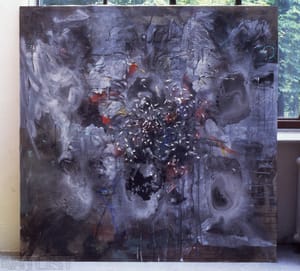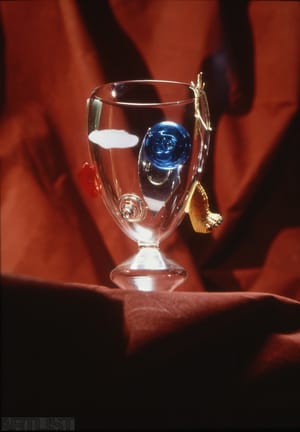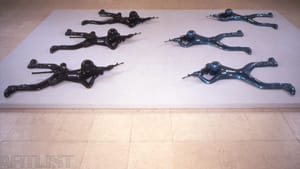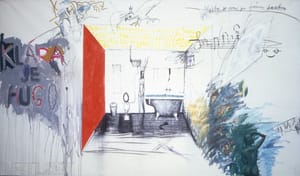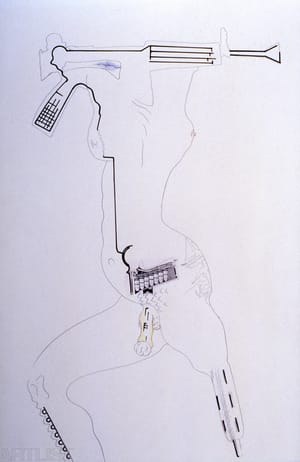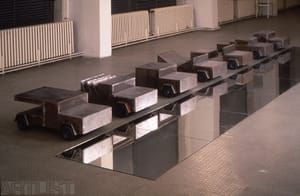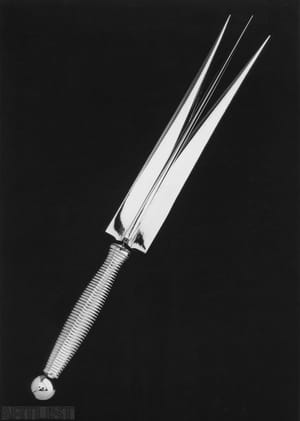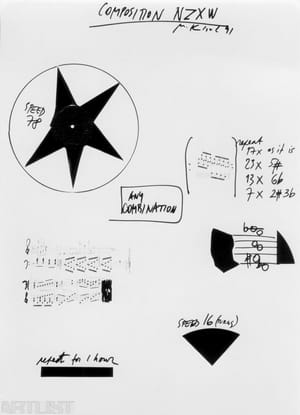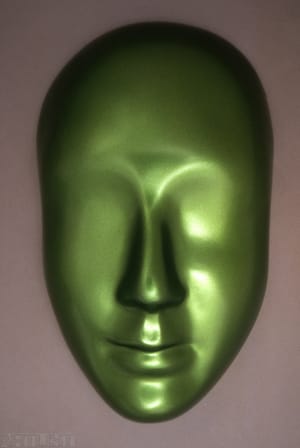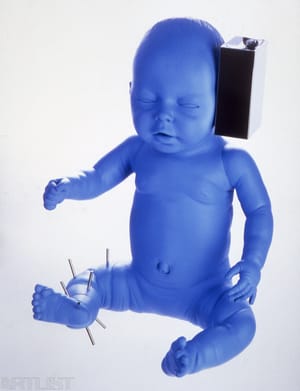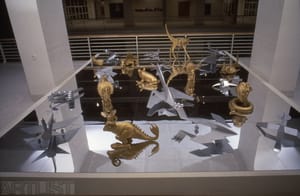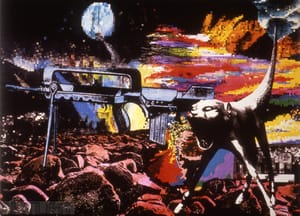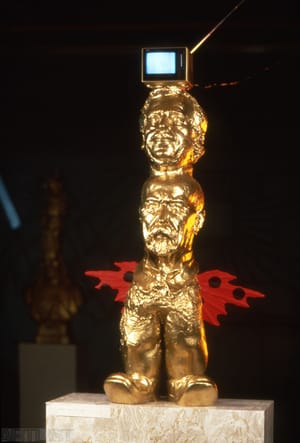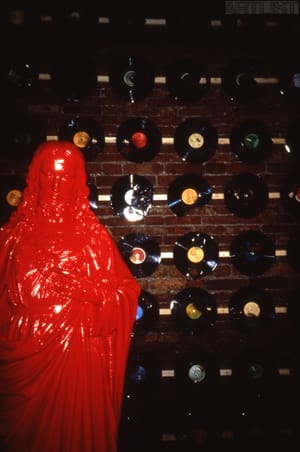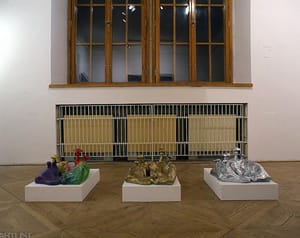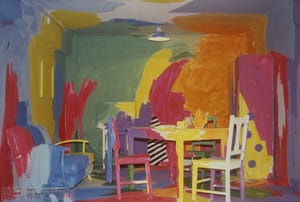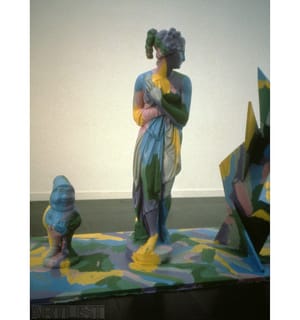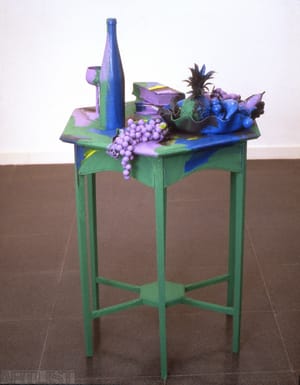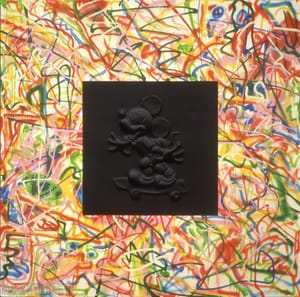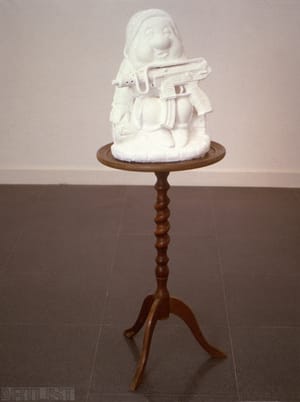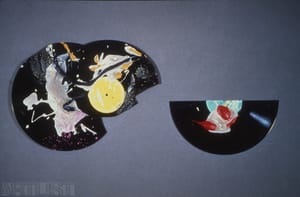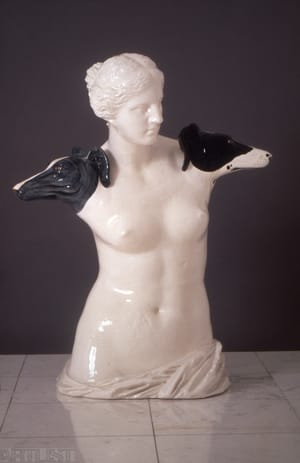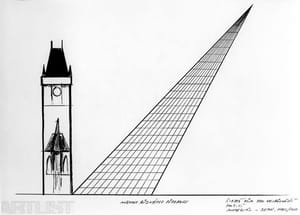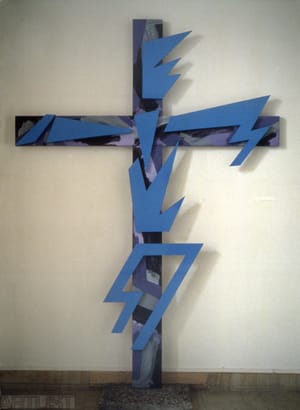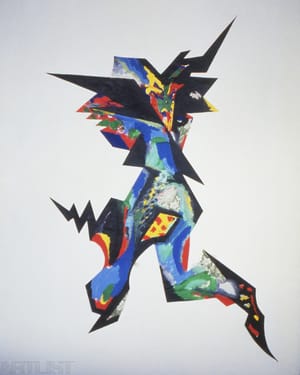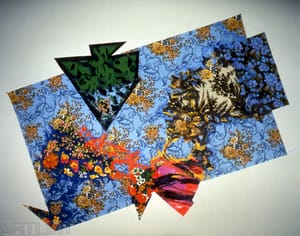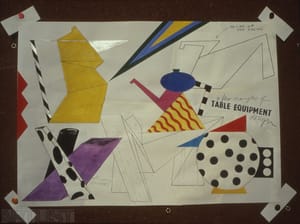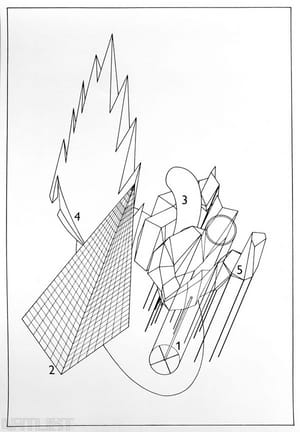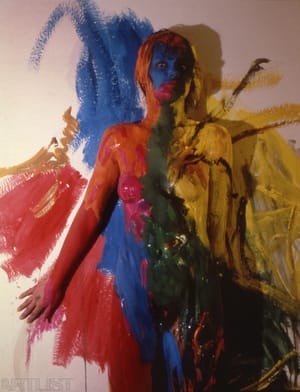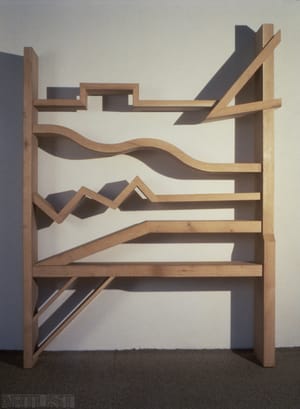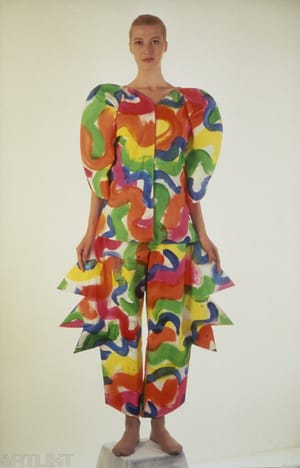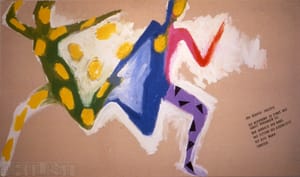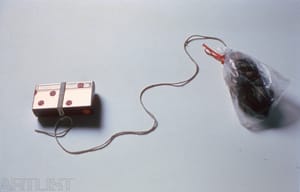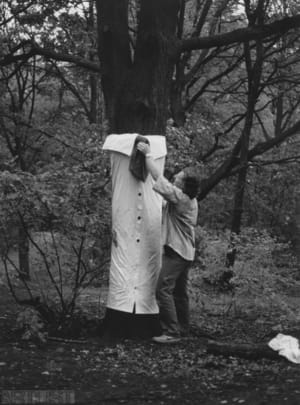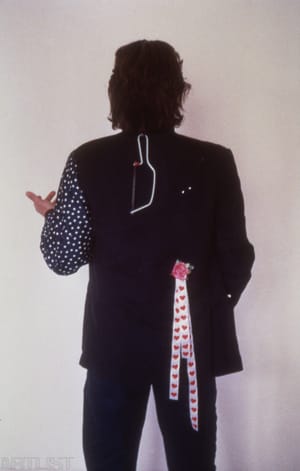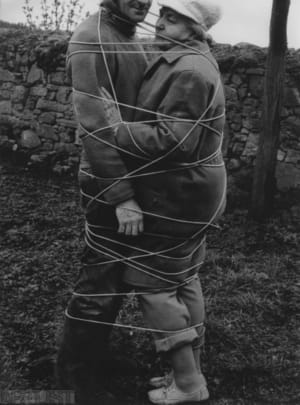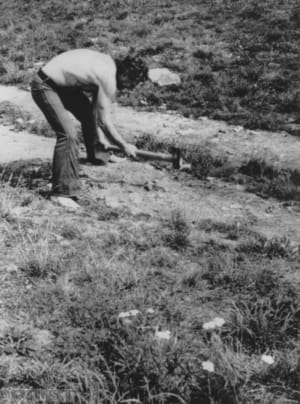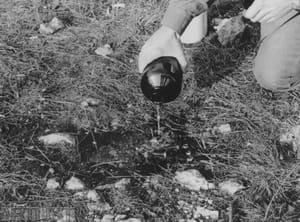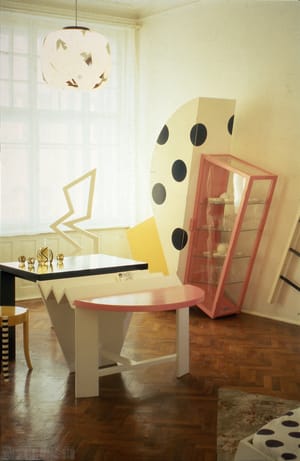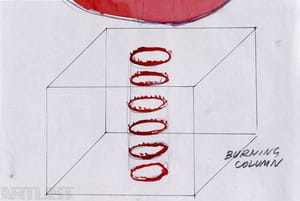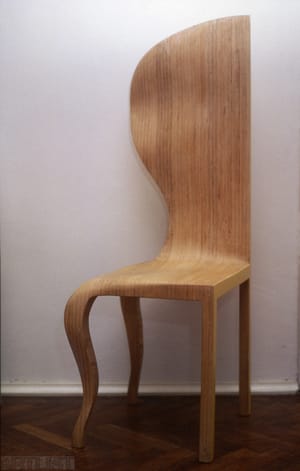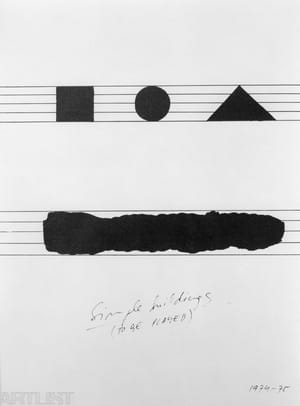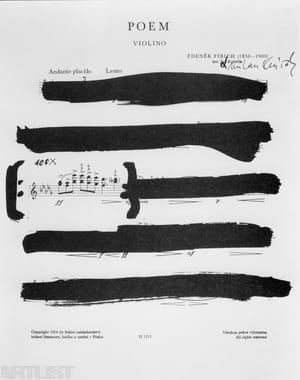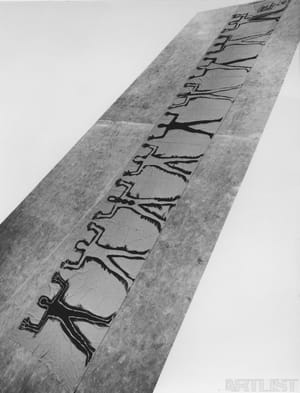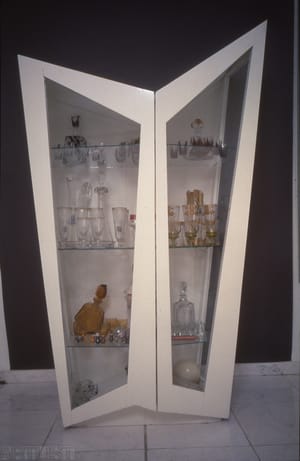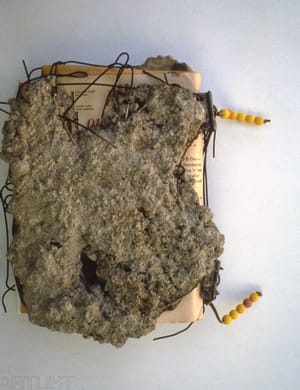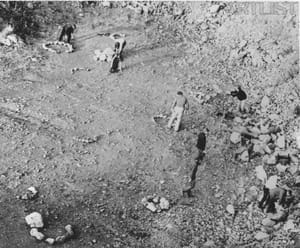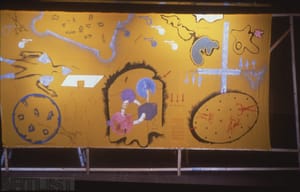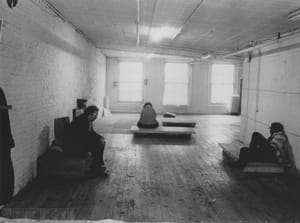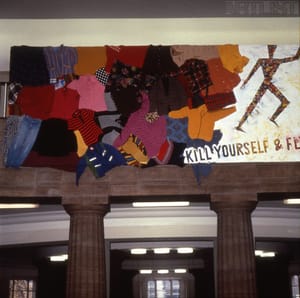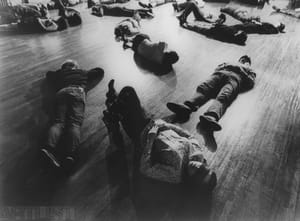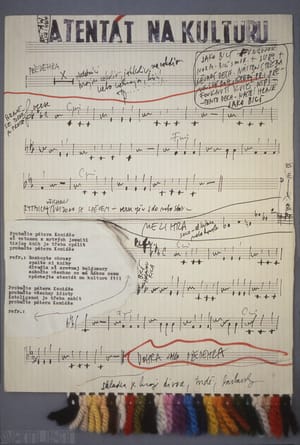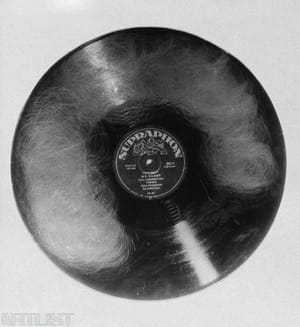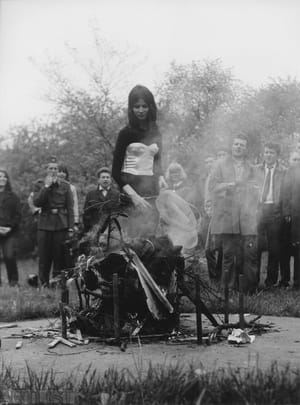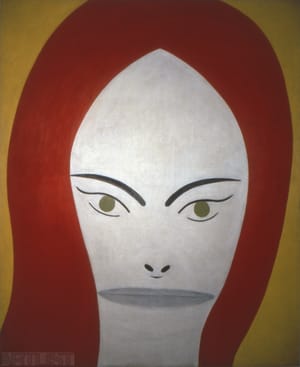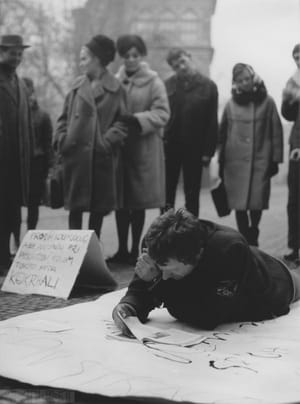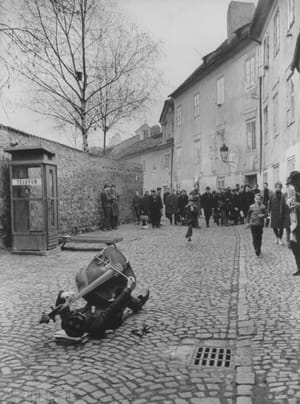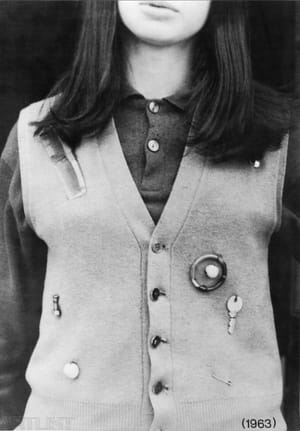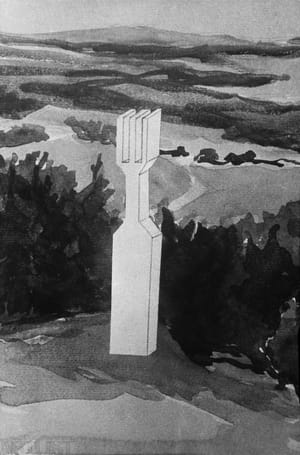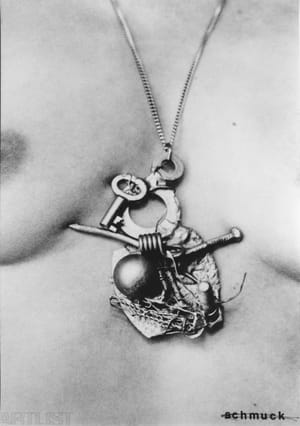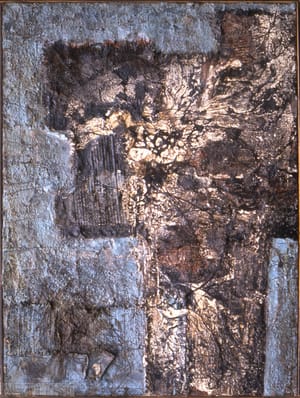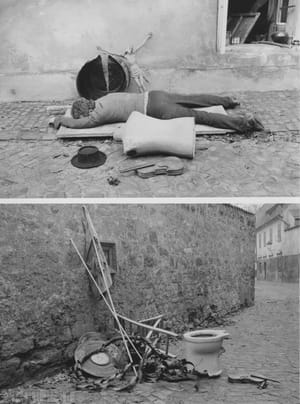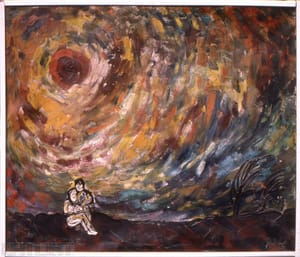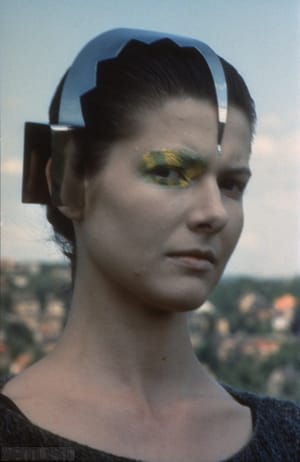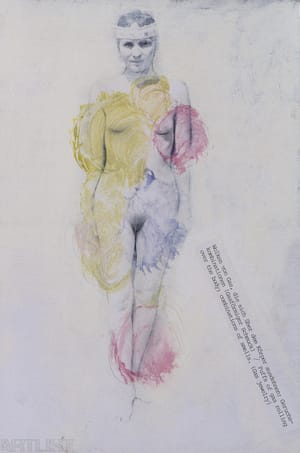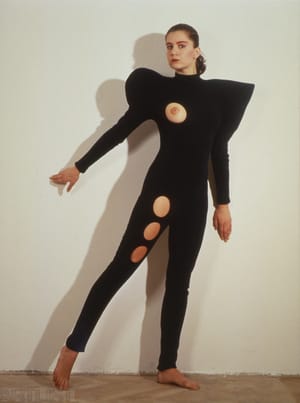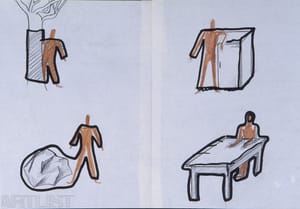- First Name
- Milan
- Surname
- Knížák
- Born
- 1940
- Birth place
- Plzeň
- Place of work
- Praha
- Website
- www.avu.cz/intermedialni
www.avu.cz/intermedialni/knizak/KnizakMilan_zivotopis.pdf
http://www.milanknizak.com/
- CSU Library
- ↳ Find in the catalogue
About artist
I.
Milan Knížák is an artist whose activities extend into many spheres both inside and outside the art world. His artistic activities include events, fine art, music, architecture, design, fashion, poetry and photography. However, more important than the spheres in which he is active or the media he uses is the fact that he often works in several spheres at once, and that these spheres and media permeate each other and extend across the wide range of his activities.
The diversity and of his activities and the expressive devices he uses are the result of on the one hand his disposition, and on the other his conviction that life and art are deeply linked internally. This means that his art works are also perceived in association with his non-creative social activities. This social dimension is an organic part of his work, since Milan Knížák never wanted simply to create artefacts which would represent him.
Knížák’s creative career began in the 1960s. In his own words, this phase of his work represents an attempt to make of art an ars vivendi (c.f. for example the text of the action lecture Why That Way 1964). He attempts to bring art closer to everyday life and thus provide both art and life another dimension. He created Short Lived Street Exhibitions (1962-64) and various street environments. The emphasis Knížák placed on the totality of life and the connections between all aspects of life led him to look not only for new possibilities of presenting art, but new expressive positions and forms of artistic activity. In his events, art is not restricted only to the professional artist or a circle of experts. It does not only operate within the institutionalised context of a gallery, exhibition or concert hall, and not only for a selected party interested in advance, but enters life as it is lived. The encounter with an artwork is not a secondary, intellectually sensual pleasure, but a challenge to change our lives, i.e. to change our approach to life. (The new expressive forms Knížák uses, i.e. events, manifestations, demonstrations, etc. can also be included under the concept of art and extend the boundaries of what we mean by the word art, though at that time it was not important to Knížák if this was the case, since these new forms for him did not lose their instrumental purpose, i.e. they represented a training in life). This difficult and on a wider scale unrealisable programme, reflecting the overall mood of the 1960s, is the decisive axis of all his artistic and life endeavours. His attempt to incorporate events into the lives of their participants is an endeavour to incorporate art (in a corresponding form) into other life situations. It is the attempt to provoke its recipients to reflect, to discover in themselves the ability to leave behind customary social forms and conceptual stereotypes, and to learn to recognise and appreciate new experiences and to be open to the pleasure to be derived therefrom. Even though in the end the attempt to link art and everyday life cannot be achieved because of their constitutive differences (different methods of perceiving, experiencing and comprehending the contexts in which we find ourselves), the endeavour in itself extends art into other spheres, including multidisciplinary and even media spheres.
Active and conceptual moments alternate and pervade Knížák’s events, people are linked to the game and invited to allow the game to be played out in their own minds. After ambitious events in which several types of activity are linked (A Walk Around the New World 1964, 2nd Manifestation of Actual Art 1965, etc.), Milan Knížák decided to concentrate on a limited number of motifs. From events focussing on social links or a certain routine way of behaving, he began to concentrate on the personal experience of the individual. Events began to appear of a psycho-physical character (Lying Ceremony 1968), or for a restricted number of participants (Difficult Ceremony 1969), in which ritual elements are important (Stone Ceremony 1971). In these events Knížák reached the deeper, more primeval layers of human life and existence. In this respect it is significant that many of his events from the start of the 1970s are entitled ceremonies. In the 70s his events become calmer and their conceptual side deeper. In the latter half of that decade several events are relocated to the space of the mind (the space of the mind is his own term). Events become concepts, though this conceptual aspect is not their only characteristic: many events still relate to human physicality (e.g. Habitation 1979, Human 1979). By virtue of their dematerialisation several events focus on the space of the mind itself (e.g. Spaces 1982). Around this time conceptual mathematically conceived events make an appearance, e.g. Events 1977 or Mathematical Problems 1977. Another difference between his events of the 1960s and 70s is that in the early works it was possible to be drawn violently into events, but as soon as the actions of an event become the inner life, the basic meaning of the event has somehow to be grasped prior to its execution. He creates events focussing on the individual’s perception, e.g. Material Events 1977, Recognition 1977, as well as events such as Friendship with a Tree 1980. This last instance, though it does not exclude a certain community, is intended for participants who are already prepared to understand it. The events were so closely linked with Knížák’s life that this was not only a type of artistic activity, but (especially in the case of his early works) a way of life in itself. This demanding approach to an event is such an important condition for its realisation that it also functions as a natural limit. This was so, for instance, in the case of Event 1984 from 1984, which does not contain any instructions regarding how it is to be executed. It becomes a kind of specific reflection on events as such. Reflection on events comes at a time when the event was waning in Knížák’s work. However, giving up events did not mean simply transferring his activities into other spheres, since the decline of events is at the same time an expression of the concept and expressive significance which they have in the work and life of Milan Knížák. In a series of events entitled Paraphrases from 1989, Knížák returns to certain of his works from the 1960s and 70s. He returns to their subjects as though to topics which can be abstracted therefrom. Events which had been executed in real space with the full involvement of physicality (or were at least so intended), are now transferred in part or completely to the space of the mind. The suspense of the original events created by their incorporation into everyday life is not transposed to the suspense of mental structures. The set of events entitled Paraphrases shows how Milan Knížák deserted what were originally physically and materially executed events, which are no longer repeatable in respect of their physical and material intensity.
Knížák returns to pictures and painting after a relatively long silence in the latter half of the 1980s. More precisely, it was only then that he fully accepted the distinctive character of the image. Pictures from the 1960s, from the earliest phase of his work, which are not simply historical documents but are related to the whole of his output, date back to the cycle Portraits (1964). However, these pictures are so connected with other of Knížák’s activities (Short Lived Street Exhibitions, events) that they cannot be restricted only to the pictorial. Even in the 1970s Knížák used painting more as an instrument (c.f. the cycle Clothes Painted on the Body, or other paintings on textile, etc.), rather than a completely independent expressive means. It was only in the latter half of the 1980s that Knížák discovered painting as such. The result was a number of paintings discovering the medium and reacting to the postmodern paradigm. Sculptural elements appear in some pictures (e.g. Pictures Painted on POP 1989, etc). At the end of the 80s the artist begins painting on objects. It is worth remembering in this respect his early work such as Statue of a Table (1964), Statue of Trousers (1964), etc. The paintings on objects from the end of the 1980s are not conceptual so much as emotional, featuring expressive colour tones.
At the start of the 1990s, Knížák began to concentrate on sculpture. Craftsmanship and formal qualities acquire a predominant role. Previously he had not regarded the craftsmanship of his work as important and had almost wilfully neglected it. Now he emphasised it. However, this was not simply about a purely instrumental method of working. Purity of craftsmanship freed of random movement becomes, along with material perfection, a means of liberating the resulting form from excessive subjectivity and an immediate dependency on the materials. The perfection of the resulting shape, replacing the unrepeatability of the personal processing procedures of industrial production, allows for a greater focus on the artist’s own intention and draws attention indirectly to the more general contents of the work, so that artefacts becomes signs and symbols. The form of processing is now a reminder of Knížák’s conceptual endeavours. It is around this time that the series of works entitled New Paradise is created. This free cycle includes the graphic designs Illustrations to a New Bible 1990, Biblical Landscapes 1991, the installations New Paradise 1990-91, Mutants 1991, 1376-1382 1992, a series of drawings entitled BMC 1992-94, and the installation Barbie 1994-95. A series of masks entitled First Twelve 1991-92 and the installation Creatures and Slightly Gentler Creatures 1993-94 are processed in a similar way.
This overview of the development of Milan Knížák’s work examining individual creative periods and outlining the predominant expressive resources that belong to it, can only offer a partial view of his work. A more important character of Knížák’s creative method, though one which is difficult to put into words, is the interplay of his activities, the breadth of the activities which mutually influence each other, forming a variable and polymorphous background to his individual works.
II.
The next part of this text on Milan Knížák offers examples of his work in the spheres of architecture, music, fashion, jewellery design and production, furniture and interior design. The classification of these spheres of his work corresponds to that given in the first part of this text.
This means that even in this sphere of his oeuvre we can find links with external conditions (materials and social conditions, e.g. the possibility of working in a studio, sales possibilities, various forms of pressure from the authorities, etc.) and internal conditions (his personal development, the immanent development of a certain creative problem, etc.)
Certain accents characteristic of individual periods can be found in Knížák’s work. Certain works from the 1960s, e.g. Fork Building (1963-64), Destroyed Music (1965), Actual, Updated Clothing (1964), Clothes Painted on a Body (1965), Tearing Jewels (1962-70), Jewels for the Entire Body (1963-1964), relate to and supplement in many respects other of the artist’s activities of that time, above all his events. Action, a focus on the public and a certain non-artistry and personal commitment could characterise this early period of Knížák’s output.
At the end of the 1960s and during the 70s it was ceremonies and rituals which resulted from the artist’s demonstrations. In the 1970s, as a consequence of external circumstances, Knížák documented his activities during the 60s and developed and elaborated many themes of his works. The conceptual character of his output intensified. Thinking through certain principles resulted in marginal designs within the framework of the sphere in question. At that time Knížák was thinking about intangible architecture, which led him, for instance, to write the large text entitled An Attempt at a Non-systematic Introduction to the Problem of Intangible Architecture (1970-1985), from which this work includes the excerpt Game of Architecture (1974-1975). At the same time he was creating a comprehensive design for the City in a Desert (1969-72), which represents an architectonic-urban complex accompanied by a vision of a different society. Knížák created musical concepts and was reflecting on the boundaries of music, an activity which resulted, for instance, in Music as Architecture (1968-76). The compositions of this period, e.g. Suspected Imagined Music (1978) or Simple Buildings (1974-1975), are consistent with his concepts, e.g. Mathematical Problems (1977) or conceptual events, e.g. White Process (1977). He also reflected on clothing, its function and characteristics. This resulted in designs of basically unwearable clothes, for instance Symbiotic Clothing (first half of the 70s). He came up with the conceptual draft of Clothes Which Are Not Worn (the text was written on the basis of work with clothes between 1962 and 1977). Knížák also investigated the sphere of jewellery and designed several unusual pieces of jewellery, e.g. imaginary jewellery, secret jewellery, invisible jewellery, non-jewellery, etc. Gaseous Jewellery (first half of the 70s) is an example of his method of working in which part of the creative design is a new definition of the problem. He takes the same approach when designing furniture and interiors. Furniture takes on completely unusual forms, e.g. that of a pillar of sound, rooms divided by sound, coloured tapes, gaseous furniture, etc. This conception of furniture and interior decor includes the works Fire Pillar (1974-1975). Knížák also created series of furniture, e.g. Cocub (1971) and Softhard (1974), which reveal his ability to create new perspectives on traditional forms of furniture.
This ability to approach a relatively stabilised sphere in a new way is characteristic of his later works. He creates his fashion, jewellery and furniture designs mainly in the 1980s. He put together many fashion collections, e.g. New Asymmetric (1983), Fur (1983), Softhard (1983), Naked Breast (1970-1986), and a collection of Painted Clothes (1988). He designed collections of jewellery for the face (1970-1985), the nose (1986), the eyebrows (1986), the lap (1973-1986), for the breasts and cheeks (1970-1985), earrings covering the entire ear or changing their form (1985-1986), jewellery for fingers (1989), etc. Many of his works cast a new look on traditional furniture, e.g. Table-Non-table (1983-84), Multifunctional Table (1985), Table for the Big Boss (1986). In the 80s, he designed various sets of tea pots and cups, vases, goblets and glasses, cars, violin heads, altars and monstrances.
A short list of Knížák’s activities giving several examples, and the division of his oeuvre into three periods (which could be characterised as action, conceptual and postmodern) is for methodological purposes above all. Finding certain regularities in his work (conceptual constants, characteristic approaches, etc.) is intended above all to create a kind of basis for realising that these divisions leave out something fundamental from his work. These schematic categories (necessary if we are to get to grips at all with the problem) force a kind of sequence on his activities and the existence of individual, concurrent spheres into which his works can be classified (event, painting, architecture, music, fashion, design, etc.). What is more important, though difficult to describe systematically, is that the work of Milan Knížák can be approached across and through individual spheres and that these spheres are not even spheres from a certain point of view, i.e. they are not specifically fields (i.e. fields in which only certain phenomena belong and no others). Knížák has an aversion to such definitions. Items, phenomena, facts, etc. can be something other than what they are usually regarded as. This apparently trivial fact lends them a certain ambiguity which is finally symptomatic of most of his works and for his oeuvre as a whole. The conceptual playfulness with which Milan Knížák transforms the significance of items and situations and dissolves the original boundary of artistic disciplines while creating other boundaries, makes his work difficult to grasp. It is not just that his activities are difficult to define, but that they force us in many cases to mimic his activities in order that we ourselves initiate a similar process and subject ourselves to a playfulness which is not specified in advance. In addition, the work of Milan Knížák is not concentrated on several artistic problems (themes) but more on an ambiguity which is very difficult to pin down and which, thanks to our actions, the items can keep acquiring anew.
CV
Studies:
1997-1998 PhD studies at Academy of Fine Arts Prague
1976-1977 Faculty of Mathematics and Physics, Charles University, Prague
1963-1964 Academy of Fine Arts Prague
1957-1958 Faculty of Education, Charles University, Prague
Awards:
2010 Prize of the State for Merit in Culture and Arts
2006 Universitas Masarykiana Foundation Award, Masarykova univerzita, Brno
2002 “ARTeon”, Poznan
1997 Medal of the Ministry of Education, Youth and Sports
1992 V. International Triennale of drawing, Wroclav, Poland
1977 Jiří Kolář Award
Employment:
since 1990 Professor and director of intermedia studio at the Academy of Fine Arts, Prague
1987-2007 International Sommerakademie Salzburg
1998 Profesor Ecal école cantonale d’art de Lausanne
1997 Sommer Workshops (Vitra Desing Museum a Centre Georges Pompidou) Domaine de Boisbuchet
1995-1997 Profesor Summerakademie Gomera, Islas Canarias
1991-1992 Vitra museum, Workshop, Weil am Rhein
1991 Sommeracademie, Berlin
1969 UCLA Los Angeles, USA
1969 University of Kentucky, Lexington, USA
- Member of art groups included in ARTLIST.
- Member of art groups not included in ARTLIST.
- Fluxus
Exhibitions
- Solo exhibitions
-
2007
Práce z poslední doby, Mánes, Praha
Umění je jen berla, Masné krámy, Plzeň
2005
Milan Knížák, Uměleckoprůmyslové muzeum, Moravská galerie, Brno
2004
Milan Knížák, Egon Schiele Art Centrum, Č.Krumlov
2003
Slečny z mé hlavy, Výstavní síň Mánes, Praha
2000
S radostí nikam, Galerie Mánes, Praha
1996
Nový ráj, Mánes / Uměleckoprůmyslové muzeum, Galerie Genia Loci, Praha
1998
Betonové sochy pro exteriér, eden CONCON’ 98, Veletržní
palác, Praha
Prázdniny s vetřelcem, Galerie V. Špály, Praha
1997
Skrytá originalita, Galerie Kramář, Praha
Nejistý pohled, Galerie Caesar, Olomouc
1996
Nový ráj, Výstavní síň Mánes, UMPRUM museum, Praha
Trosky nového ráje, Galerie Genia Loci, Praha
1995
Stůl jako obraz, obraz jako stůl, Galerie Genia Loci, Praha
1994
Zmatené obrazy, Galerie AVU, Praha
Reichstag, Berlín, DE
1993
Hrad v kradu, Galerie Sovinec
BMC, Galerie MXM, Praha
North School of Art, Adelaide, AU
Kašlu na vás, chci bejt pták, Muzeum umění Olomouc
Milan Knížák, Objekte, Sklulpturen, Galerie Traklhaus, Salzburg, AT
1992
Něco, Galerie U bílého jednorožce, Glerie Klatovy/Klenová / KaSS, Mariánské lázně / X centrum galerie, Plzeň / Povážská galéria, Žilina, SK
UFO-OFU, Galerie MXM, Praha
1991
Museo-Mudima-Fondazione, Milano, IT
Galerie Ghislave, Paříž, FR
Galerie Baecker, Kolín nad Rýnem, DE
1990
GHMP, Praha
Galerie B. Rejta, Louny
Galerie 4, Cheb
Prašná brána, Praha
Holešovická tržnice, Praha
Prodomo, Vídeň, AT
Bratislava, SK
1989
Milan Knížák 1953-88, DUMB, Brno
1988
Design, Galerie DAAD, Berlín, DE
A Bit of Architecture, Kulturní středisko Opatov, Praha
1987
Museum Bochum, DE
Milan Knížák 1985-86. Kleider auf dem Körper gemalt, Sprengel Museum, Hannover, DE
Burning Mind Projects, Galerie Wewerka, Hannover, DE
Ústav makromolekulární chemie ČSAV, Praha
Galeria Potocka, Krakow, PL
Liget galéria, Budapešť, HU
1986
Galleria UXA, Novara, IT
Lauter Ganze Hälfte, Kunsthalle Hamburg, DE
Softhard, Museo Alchimia, Milano, IT
1985
Galerie Camomille, Brusel, BE
1984
Galerie Baecker, Bochum, DE
Licht und Raum Design, Kolín nad Rýnem, DE
1983
Neue Gedanken, Galerie Ars Viva, Berlin-West, DE
1980
Galerie Ars Viva, Berlin-West, DE
Galerie Baecker, Bochum, DE
Kunstverein Oldenburg, DE
1976
Galerie "A", Amsterdam, NL
1972
Museum am Ostwald, Dortmund, DE
1970
Galerie Art Intermedia, Kolín nad Rýnem, DE
1968
Fluxus West, San Diego, USA
1964
Poetická kavárna Viola, Praha
1963
Výstava na zdi, Nový Svět, Praha
Malostranská beseda, Praha
1958
KaSS, Mariánské lázně
- Collections
-
Zastoupení ve významných sbírkách soukromých i státních
Fluxeum, Wiesbaden
Galerie B. Rejta, Louny, Česká republika
Graphothek, Brémy
Jeanne Brown´s Collection, Mass., USA
Kunstmuseum Bochum, Bochum
Kunsthalle Hamburg, Hamburg
Moravská galerie v Brně, Brno, Česká republika
Mudima Foundation, Miláno, Itálie
Museo Vostell, Malpartida de Cáceras, Španělsko
Museum am Ostwall, Dortmund
Museum für Kunst und Gewerbe, Hamburg
Museum Checkpoint Charlie, Berlín
Museum Narodowe, Varšava, Polsko
Museum Sprengel, Hannover
Národní galerie v Praze, Praha, Česká republika
Neuberger Museum, New York, USA
Památník národního písemnictví, Praha, Česká republika
Sammlung Feelisch, Remscheid
Sammlung Ludwig, Aachen
Monography
- Articles
Václav Janoščík, Vše je ve stavu Fluxu (recenze výstavy Fluxus East/Fluxus Networks in Central Eastern Europe), A2 kulturní týdeník, 30/ 2008
18. 4. 2008, Iniciativa "Čas změny" - otevřený dopis mininistru kultury, Český rozhlas, Mozaika, K. Oujezdský
www.rozhlas.cz/mozaika/vytvarne/_zprava/445931
11. 4. 2008, Radek Wohlmuth, Výtvarníci žádají ministra o odvolání Knížáka aktualne.centrum.cz/kultura/umeni/forum.phtml]
31. 1. 2008, Radek Wohlmuth, Jsem Milan Knížák a kupuji předražená díla, aktualne.centrum.cz/kultura/umeni/clanek.phtml
26. 1. 2008, Čt 24, pořad Týden v kultuře: Národní galerie koupila novou plastiku - www.ct24.cz/vyhledavani/index_view.php
25.1.2008, Naďa Klevisová, hn.ihned.cz, VÍKEND, rozhovor - hn.ihned.cz/c1-22820150-milan-knizak-lidem-casto-chybi-odvaha
25. 1. 2008, Čt 24, reportáž Lucie Klímové a Evy Valjarevičové: Nákupy ředitele Národní galerie Milana Knížáka prošetřuje policie - www.ct24.cz/vyhledavani/index_view.php
23. 1. 2008, Český rozhlas, Milan Knížák - Podivný Kelt, Karel Oujezdský rozhovor - www.rozhlas.cz/mozaika/vytvarne/_zprava/417091
21. 1. 2008, Čt 24, Milan Knížák není Milan Knížák, video - www.ct24.cz/vyhledavani/index_view.php
14.12.2007, Respekt.cz, Jan H. Vitvar, Další problém Milana Knížáka, glosa - www.respekt.cz/externality/Glosy/Dalsi-problem-Milana-Knizaka.html
12. 12. 2007, Radek Wohlmuth, Celebritózní umělec Knížák si hraje na rebela, aktualne.centrum.cz/kultura/umeni/clanek.phtml
10. 12. 2007, Vilém Faltýnek, ČRo 7 - Radio Praha, Udělením ceny NG 333 obhajuje Knížák kriminalizované umělce, rozhlasová reportáž - www.radio.cz/cz/clanek/98512
1.12.2007, ČT24, Z metropole o výstavě Milana Knížáka, video - www.ct24.cz/vyhledavani/index_view.php
29.11.2007, ČT24, Milan Knížák: Práce z poslední doby - www.ct24.cz/vyhledavani/index_view.php
8. 8. 2007, ČRo Radio Wave, Guestlist s Milanem Knížákem - www.rozhlas.cz/radiowave/guestlist/_zprava/369565
1. 5. 2007, Ondřej Černý, ČRo Rádio Česko, diskuse - www.rozhlas.cz/radio_cesko/sc/_zprava/341889
7. 12. 2006, Čt 24, pořad Před půlnocí s Milanem Knížákem - www.ct24.cz/vyhledavani/index_view.php
8.11.2006, Jan Rosák, Český rozhlas Region, Středočeský kraj, Tandem s Milanem Knížákem - www.rozhlas.cz/strednicechy/tandemprepisy/_zprava/292566
28. 7. 2006, Václav Suchan, Blesk, Milan Knížák, šéf Národní galerie: Sní za hranicemi zákona!, rozhovor - www.blesk.cz/Clanek57047.htm
30. 6.2006, Literární noviny 2006-26, Prospívá Milan Knížák Národní galerii?, - www.literarky.cz
2005, Reflex 33/2005, Petr Volf, Doktor loutek, rozhovor - www.reflex.cz/Clanek20764.html
7. 12. 2004, Vilém Faltýnek, ČRo 7 - Radio Praha, Brody: Ještě asi hodinu to tam leželo, rozhovor - www.radio.cz/cz/clanek/61052
26. 11. 2004, iDNES.cz, ČTK, Mladí umělci káleli v Národní galerii - show.idnes.cz/show_aktual.asp
23. 3. 2004, ČRo 7 - Radio Praha, Zdeněk Vališ, Knížák rezignoval na evropského poslance,rozhlasová reportáž - www.radio.cz/cz/clanek/52003
19. 2 . 2003, ČRo 7 - Radio Praha, Milan Knížák se svými studenty protestoval proti novým pražským sochám, Milena Štráfeldová, rozhlasová reportáž - www.radio.cz/cz/clanek/37733
8. 4. 2002, online rozhovor, www.reflex.cz/Clanek9054.html
1. 3. 2002, Alžběta Janíčková, Co vytýká Milan Knížák Romům, rozhovor - romove.radio.cz/cz/clanek/18281
nedatováno, Kulturně hospodářská revue FRAGMENTY, Josef Fousek, báseň - www.fragmenty.cz/archiv/!43%20N%C3%A1rodn%C3%AD%20galerie.htm
nedatováno, Kulturně hospodářská revue FRAGMENTY, Ivana Haslingerová, Knížák a loutky - jak se to rýmuje...?, článek - www.fragmenty.cz/j1114.htm
nedatováno, Kulturně hospodářská revue FRAGMENTY, Ivana Haslingerová, Knížák vyzbrojuje teroristy, reportáž - www.fragmenty.cz/iz00227.htm
nedatováno, Kulturně hospodářská revue FRAGMENTY, Milan Knížák, Knížákova smršť 36, www.fragmenty.cz/zzSmrst.pdf
nedatováno, Kulturně hospodářská revue FRAGMENTY, Milan Knížák, Knížákova smršť 35, www.fragmenty.cz/iz00062.htm
- Personal texts not included in database
Milan Knížák - Akce, Gallery, 2006
Panoptikum Milana Knížáka, Sloupky z Reflexu 1995 - 1998, Votobia, 2000
